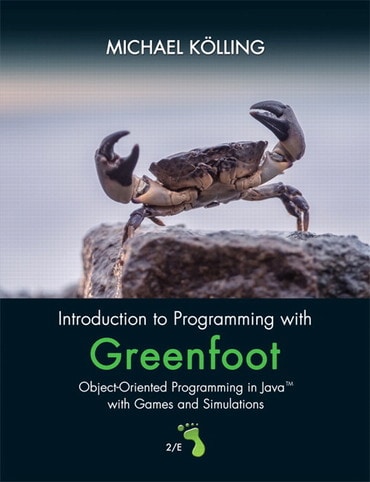
Title overview
For courses in programming and computer science.
Hands-on Programming with Greenfoot
Introduction to Programming with Greenfoot: Object-Oriented Programming in Java with Games and Simulations teaches the basics of Java computer programming languages in the context of Greenfoot. Students are able to learn the general fundamentals and principles of programming by creating their very own fun and interesting games and simulations. Major concepts are conveyed in modern, object-oriented programming language through hands-on, practical activity that allows students to create, observe, and play.
The Second Edition employs a unique approach that teaches by doing--concepts are often explained after students have had a chance to engage in interactive examples. Because of its uniquely hands-on approach in the context of the Greenfoot environment, Introduction to Programming with Greenfoot makes programming a fun, interactive subject for students to enjoy.
Introduction to Programming with Greenfoot: Object-Oriented Programming in Java with Games and Simulations includes the following features to stimulate learning:
Basic Java programming principles are explored in the context of Greenfoot
- Greenfoot uses simulations and games to teach programming skills, making the topic interesting, hands-on, and enjoyable for students.
- Students have the chance to build simple games or complex, highly-structured programs in this environment, making the software accessible to a wide range of students.
- All Greenfoot examples teach basic principles of standard Java, a fundamental language in computer programming.
UPDATED! A highly interactive text teaches through hands-on examples
- NEW! Examples have been added to the text that allow students to practice programming in an enjoyable, engaging fashion, such as:
- NEW! Chapter 1: Leaves and Wombats introduces some important object-oriented concepts and Greenfoot interactions early on in the text.
- NEW! Chapter 6: Newton’s Lab is a simulation of the motion of stars and planets in space that teaches the concept of gravity.
- NEW! Chapter 10 has a variety of new examples that intend to inspire further projects, such as:
- Lifts is a start of lifts simulation that can be continued into its own project.
- Boids is a demo showing flocking behaviour through the motion of birds.
- Circles makes patterns in different colours on the screen with moving circles.
- Explosion demonstrates a sophisticated explosion effect.
- Breakout is the beginning of the classic breakout game with an interesting visual effect.
- Platform jumper is a demonstration of this popular simulation.
- Wave is the simulation of the propagation of a wave on a string.
- Projects are introduced first with interactive examples and later explained theoretically, allowing students to practice skills they are learning before understanding dry material.
- Engaging examples in the form of games, simulations, and music make programming fun and stimulating for all students.
- Exercises are integrated throughout the text to help students consistently practice major concepts.
- Pedagogical features guide the text, making it easily readable for students.
UPDATED! A highly interactive text teaches through hands-on examples
- Examples have been added to the text that allow students to practice programming in an enjoyable, engaging fashion, such as:
- Chapter 1: Leaves and Wombats introduces some important object-oriented concepts and Greenfoot interactions early on in the text.
- Chapter 6: Newton’s Lab is a simulation of the motion of stars and planets in space that teaches the concept of gravity.
- Chapter 10 has a variety of new examples that intend to inspire further projects, such as:
- Lifts is a start of lifts simulation that can be continued into its own project.
- Boids is a demo showing flocking behaviour through the motion of birds.
- Circles makes patterns in different colours on the screen with moving circles.
- Explosion demonstrates a sophisticated explosion effect.
- Breakout is the beginning of the classic breakout game with an interesting visual effect.
- Platform jumper is a demonstration of this popular simulation.
- Wave is the simulation of the propagation of a wave on a string.
Table of contents
CHAPTER 1: Getting to know Greenfoot
CHAPTER 2: The first program: Little Crab
CHAPTER 3: Improving the Crab— more sophisticated programming
CHAPTER 4: Finishing the crab game
Interlude 1: Sharing your scenarios
CHAPTER 5: Scoring
CHAPTER 6: Making music: An on-screen piano
CHAPTER 7: Object interaction: an introduction
CHAPTER 8: Interacting objects: Newton’s Lab
CHAPTER 9: Collision detection: Asteroids
Interlude 2: The Greeps competition